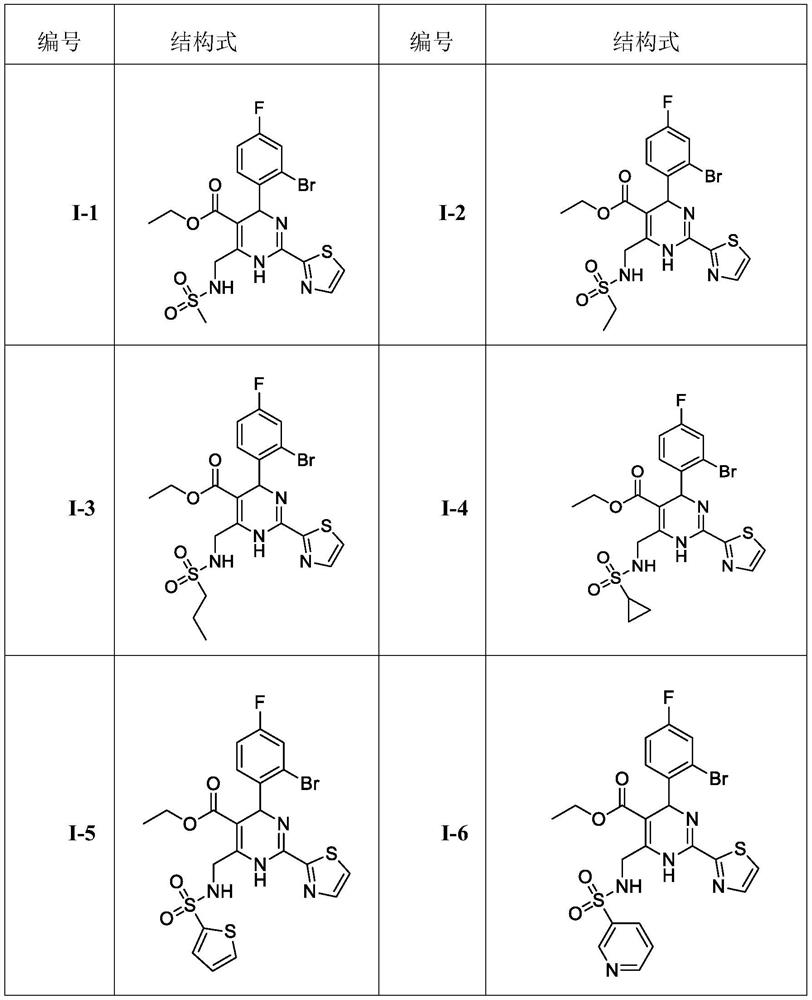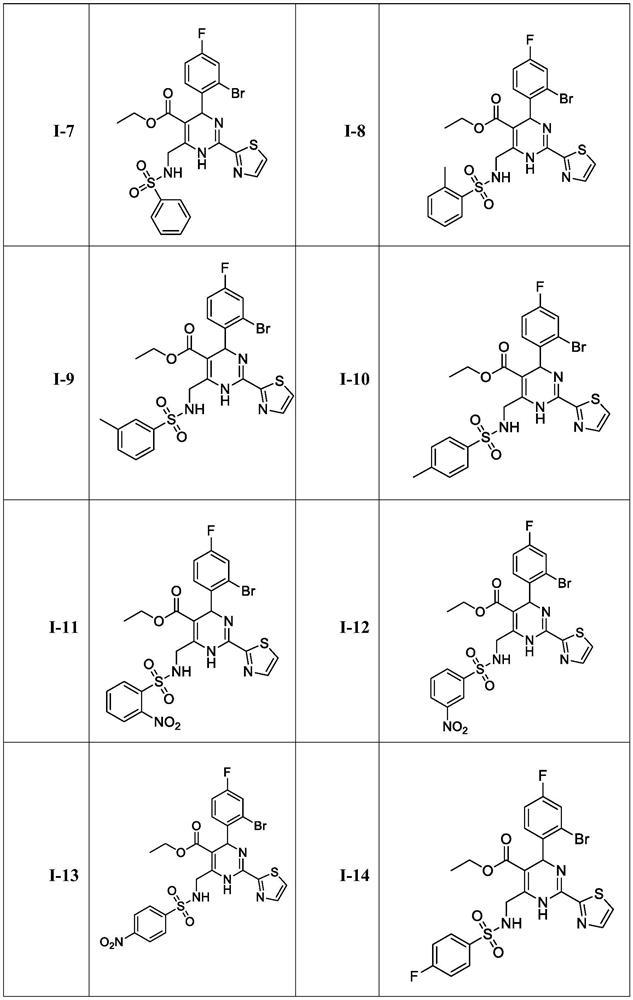Dihydropyrimidine-sulfonamide derivatives, preparation method and application thereof
A technology of sulfonamide and dihydropyrimidine, applied in the field of medicine, can solve the problems of strong liver toxicity, poor water solubility, poor metabolic stability and the like
- Summary
- Abstract
- Description
- Claims
- Application Information
AI Technical Summary
Problems solved by technology
Method used
Image
Examples
Embodiment 1
[0043] Embodiment 1. Preparation of compound 2
[0044]Dissolve 2-thiazolecarboxamidine hydrochloride (0.50g, 3.05mmol) in 50mL of absolute ethanol, and add 2-bromo-4-fluorobenzaldehyde (0.93g, 4.60mmol) and ethyl acetoacetate successively at room temperature (600μL, 4.60mmol), sodium acetate (0.50g, 6.13mmol), 80 ℃ reflux reaction for 6h; 25mL x 3), combined the organic phases, washed once with saturated brine (25mL), dried over anhydrous sodium sulfate; concentrated, dry-loaded, separated on a silica gel column by flash preparative chromatography, recrystallized from a dichloromethane-n-hexane mixed solvent to obtain a yellow solid 0.75g, yield 58%; melting point 153-156°C.
[0045]
[0046] Compound 2 spectral data: 1 H NMR (400MHz, CDCl 3 )δ7.81(d, J=2.8Hz, 1H), 7.46(s, 1H), 7.38–7.28(m, 2H), 6.97(t, J=8.2Hz, 1H), 6.15(s, 1H), 4.05(q, J=7.1Hz, 2H), 2.53(s, 3H), 1.13(t, J=7.1Hz, 3H); EI-MS: 424.3[M+H] + .
Embodiment 2
[0047] Embodiment 2. Preparation of Compound 3
[0048] Intermediate 2 (0.50g, 1.17mmol) was dissolved in 50mL of carbon tetrachloride, NBS (0.22g, 1.24mmol) was slowly added, and the reaction was refluxed at 50°C for 2h; after the reaction, cooled to room temperature, the tetrachloride was removed by rotary evaporation carbonization, add water (50mL), extract three times with ethyl acetate (20mL x 3), combine the organic phases, wash once with saturated brine (25mL), dry over anhydrous sodium sulfate; concentrate, dry load, and quickly prepare a chromatography silica gel column Separation, recrystallization from dichloromethane-n-hexane mixed solvent to obtain 0.35 g of yellow solid, yield 59%; melting point 123-128°C.
[0049]
[0050] Spectral data of compound 1: 1 H NMR (400MHz, CDCl 3 )δ7.84(d,J=3.1Hz,1H),7.52(s,2H),7.44–7.35(m,1H),7.32(dd,J=8.1,2.6Hz,1H),7.02(t,J =8.0Hz,1H),6.09(s,1H),4.94(d,J=8.9Hz,1H),4.61(s,1H),4.09(d,J=7.0Hz,2H),1.16(t,J =7.1Hz, 3H); EI-MS: 50...
Embodiment 3
[0051] Embodiment 3. Preparation of Compound 4
[0052] Intermediate 3 (0.50 g, 1.00 mmol) was dissolved in 45 mL of acetone, and NaN 3 (0.13g, 2.00mmol), stirred overnight at room temperature; after the reaction, cooled to room temperature, acetone was removed by rotary evaporation, added water (50mL), extracted three times with ethyl acetate (20mL x 3), combined organic phases, washed once with saturated brine (25mL), dried over anhydrous sodium sulfate; concentrated, dry-loaded, separated by flash preparative chromatography on a silica gel column, recrystallized from a dichloromethane-n-hexane mixed solvent to obtain 0.37g of a yellow solid, yield 80%; melting point 123-126°C .
[0053]
[0054] Compound 4 spectral analysis data: 1 H NMR (400MHz, CDCl 3 )δ8.64(s,1H),7.85(d,J=3.1Hz,1H),7.55(d,J=3.1Hz,1H),7.48–7.37(m,1H),7.35–7.29(m,1H ),7.10–6.92(m,1H),6.29–6.02(m,1H),4.97(s,1H),4.60(d,J=2.6Hz,1H),4.17–4.00(m,2H),1.13( t,J=7.1Hz,3H); 13 C NMR (100MHz, CDCl 3 )δ165....
PUM
| Property | Measurement | Unit |
|---|---|---|
| melting point | aaaaa | aaaaa |
| melting point | aaaaa | aaaaa |
| melting point | aaaaa | aaaaa |
Abstract
Description
Claims
Application Information
 Login to View More
Login to View More - R&D
- Intellectual Property
- Life Sciences
- Materials
- Tech Scout
- Unparalleled Data Quality
- Higher Quality Content
- 60% Fewer Hallucinations
Browse by: Latest US Patents, China's latest patents, Technical Efficacy Thesaurus, Application Domain, Technology Topic, Popular Technical Reports.
© 2025 PatSnap. All rights reserved.Legal|Privacy policy|Modern Slavery Act Transparency Statement|Sitemap|About US| Contact US: help@patsnap.com



